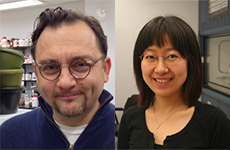Wang Lab Identifies New Neurodegeneration-Related Protein Quality Control Pathway

One common factor in neurodegenerative diseases such as Alzheimer’s, Parkinson’s, and Huntington’s diseases, along with amyotrophic lateral sclerosis and frontotemporal dementia, are problems with the cell’s protein quality control system. When this system malfunctions, misfolded and toxic proteins can build up in a process known as proteotoxicity, damaging neurons. Cells can regulate protein quality through a range of pathways, but these mechanisms and strategies are not well understood.
In a new study published in the Proceedings of the National Academy of Sciences from the lab of Jiou Wang, PhD, associate professor in the Department Biochemistry and Molecular Biology at Johns Hopkins Bloomberg School of Public Health, researchers identified a new regulatory switch for protein quality control that plays a role in the development of ALS. The work could point the way to novel therapies for ALS and other neurodegenerative diseases characterized by proteotoxicity.
Previous work in the nematode Caenorhabditis elegans had identified a variety of genes that modify and regulate protein quality control. One strategy is ubiquitination, a process that tags misfolded proteins with a molecule called ubiquitin. Ubiquitinated proteins are then targeted for recycling. Cells also contain enzymes that can remove ubiquitin tags.
“To guard against proteotoxicity, cells have evolved sophisticated quality control mechanisms that make adaptations including enhanced turnover of misfolded proteins,” said Goran Periz (above left), PhD, senior associate researcher in the Wang lab and co-lead author of the study.
Using a C. elegans model of ALS caused by mutations in the SOD1 gene, the scientists began to search for factors that would modify the proteotoxicity caused by mutated human SOD1 protein. One suppressor identified by the screen was the protein MATH-33, the equivalent of a protein called USP7 in humans. When the researchers blocked the function of MATH-33, they found a decrease in the amount of SOD1 protein aggregates. In mammalian cells including neurons that express mutant SOD1, scientists found that blocking USP7 activity improved the cell’s ability to remove mutant SOD1 or other misfolded proteins, such as TDP-43.
When the researchers dived deeper into USP7 pathways, they found that reducing the expression of USP7 activated the transforming growth factor β (TGF β)-SMAD pathway. Reducing SMAD2 production led to increased accumulation of misfolded SOD1. They then used antibodies to show that USP7 and SMAD2 were physically associated with each other, and that USP7 functions by removing a ubiquitin tag from NEDD4L, which functions to target SMAD2 for recycling. Working together, the USP7-SMAD2 pathway helps the cell eliminate toxic proteins by targeting them for recycling via autophagy.
As further evidence for the conserved function of this pathway across vastly different species, the researchers found that knocking down the expression of the fruit fly version of USP7 also reduced the climbing deficits created by SOD1 mutations. Reducing the fruit fly equivalent to SMAD2, however, increased these deficits. Similar effects of the pathway were found in a fly model expressing TDP-43 with eye degeneration defects. Intriguingly, as a point of direct disease relevance, the researcher found that the pathway is dysregulated in tissues from the spinal cords of ALS patients. Taken together, “these findings reveal a previously unknown regulatory pathway for protein quality control and provide new strategies for developing interventions for neurodegenerative diseases,” commented Tao Zhang (above right), PhD, research associate in the Wang lab and the co-lead author of the study.
This post is adapted from a Packard Center Research Byte.
